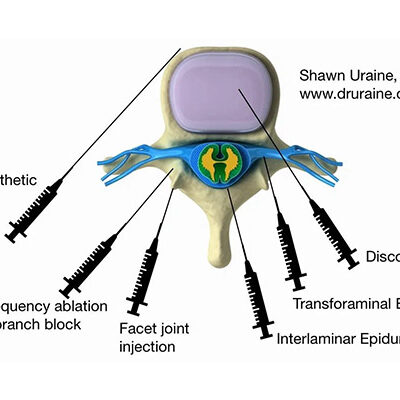Injections for pain
The needle targets several sources of pain:
1.Joints
A. Facet joint treatment target dull, achy pain which stays near the spine and is worse when the person looks up or extends the spine.
B. Pain from the facet joint has to be confirmed by diagnostic block using a local anesthetic. If the injection of local anesthetic into the joint or medial branch nerve produces pain relief, then the source of pain is identified.
C. It’s important to know how much pain relief the medial branch block or facet joint injection produced and how long it lasted.
D. Radiofrequency ablation of those same nerves can be performed for long lasting pain relief if there was concordant pain relief from the diagnostic block.
E. Risks of this procedure include bleeding, infection, paralysis, spinal cord injury, headache, and increased pain.
F. Sedation is not recommended for routine spinal injections and confuses the outcome of a diagnostic block because the sedative used can also relieve pain, therefore you cannot be certain that your injection was the source of temporary pain relief.
2.Nerves
A. Epidural steroid injections target radiating pain down the arm or leg also called “sciatica” or “zingers” of sharp shooting pain.
B. Epidurals can be performed via the interlaminar route or the transforaminal route for pain down both extremities or one side.
C. Various steroids may be selected for injection. The two major classes are particulate and non-particulate. Studies have revealed that both produce similar relief. Particulate steroids such as Depomedrol can cause spinal cord ischemia and paralysis if injected into the epidural blood vessels.
D. Epidurals can be repeated if they are effective. It is important to know how much pain relief was obtained, how long it lasted, and what functional benefit was realized before proceeding with a repeat epidural.
E. There is no role for a “series of three” injections.
F. Risks of epidurals include bleeding, infection, pain, paralysis, headache.
G. Sedation is not routinely recommended for epidural steroid injections and the use of sedation must be documented and medically necessary.
H. Spinal cord stimulation is an option for some patients with functional loss and pass a psychological screening test. A trial is required prior to implant of the electrical pulse generator.
3. Connective tissue
A. Trigger point injections into muscles and injection into ligament and tendon remain an option for carefully selected patients.
4. Example questions
Q: On a scale of 0-10 with 10 being the highest, what was your level of pain 30 minutes before the injection?
Q: What was your level of pain 30 minutes after the injection?
Q: What part of your body experienced this decreased level of pain?
Q: How long did you feel this decreased level of pain?
Q: During the period of decreased pain were you able to do more things? Need specific examples.
Q: During the period of decreased pain were you able to take less medication for pain? What were the medication/dose prior to injection and after the injection?
Q: Were you asleep for the injection? Were you given the option of not being sedated?
